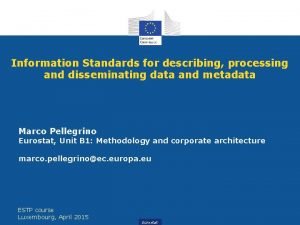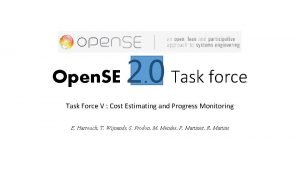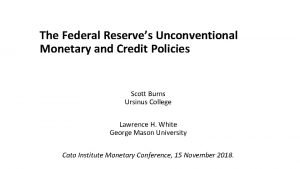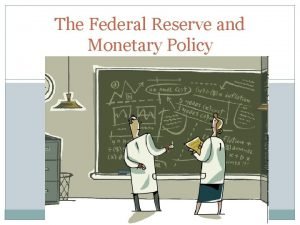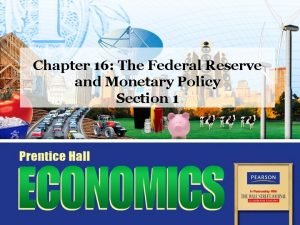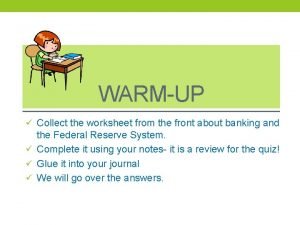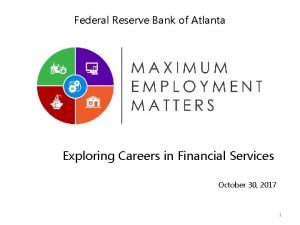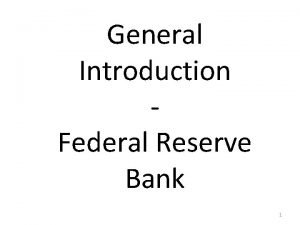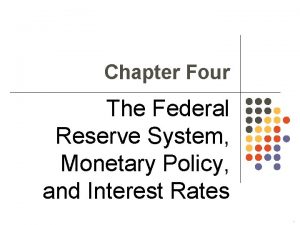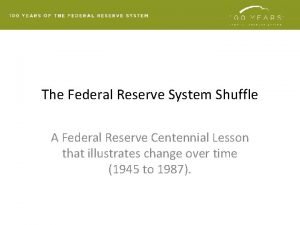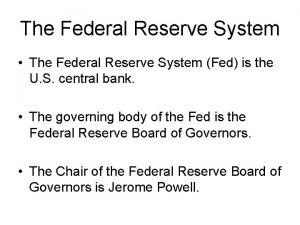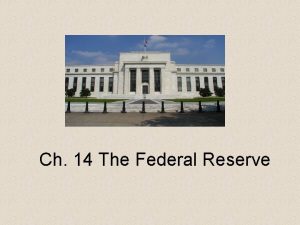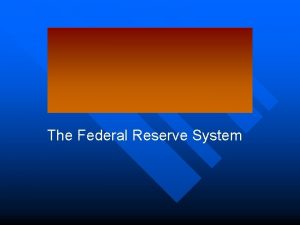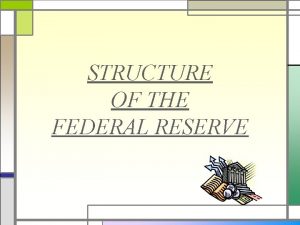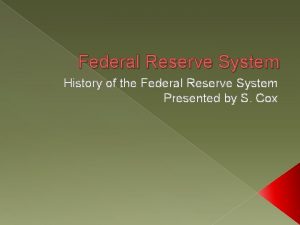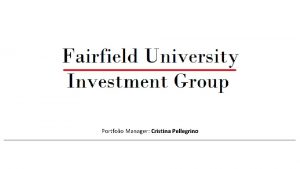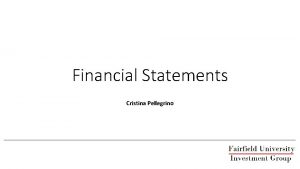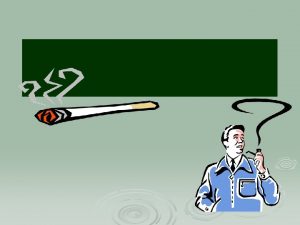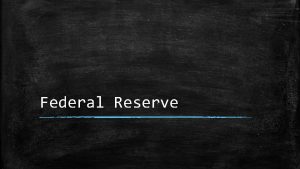The Federal Reserve Anthony Capellupo Cristina Pellegrino What












- Slides: 12

The Federal Reserve Anthony Capellupo & Cristina Pellegrino

What is the Federal Reserve? • Central bank of the United States • Promotes Five General Functions • • • Monetary Policy Stability of the Financial System Regulating and Supervising Banks Payment and Settlement System Consumer Protection and Community Development

The Structure of the Federal Reserve • The President appoints the Board of Governors and they are confirmed by the Senate. • 7 board members • 14 -year terms • 12 District Banks • Bank president is appointed by the Bank’s board of directors • Consists of 3 bankers and 6 members from the community or other industries • Must be approved by the Board of Governors • Federal Open Market Committee • • Meeting of Board of Governors (7) and Bank Presidents (12) Board chair also serves as FOMC chair Occurs 8 times throughout the year Voting: Board of Governors (7) + New York President (1) + Rotating Bank Presidents (4)

Biggest Problem with the Federal Reserve We can’t vote out individuals

Monetary Policy • Goals of Monetary Policy • Stable Prices • Employment • Moderate Long-Term Interest Rates • Tools of Monetary Policy • • • Open Market Operations Reserve Requirement Discount Rate Interest on Reserve Balances Forward Guidance

Transition Mechanism Federal Funds Rate Yield Curve Credit Market Aggregate Demand/ Aggregate Supply GDP/ Unemployment Inflation

Open Market Operations • Setting the target Federal Funds Rate, the rate banks charge each other for lending money • The Fed will buy or sell bonds from individual investors or institutions through primary dealers • Primary tool of monetary policy • Buying Bonds= Boosting Economy • The Fed pays for a bond with a deposit-> increases cash for banks-> increases reserves-> increases money supply • Selling Bonds= Slowing Economy • The Fed sells bonds in exchange for cash-> decreases cash for banks -> decreases reserves -> decreases money supply

Types of Open Market Operations • Defensive Open Market • The Federal Reserve is trying to keep the economy where it is • Dynamic Open Market • The Federal Reserve is trying to move the market in a certain direction

Reserve Requirement • Board of Governors sets a percentage of deposits that banks must keep in reserve • A lower reserve requirement increases ability to make more loans -> lower interest rates because there is more money to loan • Reserve requirements have been 10%

Discount Rate • Federal Reserves as the lender of last resort for banks • When the Federal Reserve makes a loan to a bank to increase its reserve, the interest rate on the loan is called the discount rate. • Lower rate -> increased money supply • Higher rate -> decreased money supply • Generally, there is a negative connotation surrounding banks that must use the Federal Reserve to meet reserve requirements. • This rate is usually higher than the Federal Funds Rate

Interest on Reserve Balances • In 2006, a law was passed allowing the Federal Reserve to pay interests on reserve accounts • If this rate is low compared to other options, banks will look to instead use reserves to make loans to earn a higher interest rate • If this rate is high compared to other options, banks will choose this rate because it is less risky

Forward Guidance • Communicate monetary policy goals, tools, and profess through different types of media to the public. • This is beneficial because it gives direction, but it is bad if the Fed does not follow through with their guidance • Expectations are usually priced into the market
 Marco pellegrino
Marco pellegrino Difference between capital reserve and reserve capital
Difference between capital reserve and reserve capital Source of capital reserve
Source of capital reserve Contingency reserve vs management reserve
Contingency reserve vs management reserve Federal reserve system pyramid
Federal reserve system pyramid Federal reserve bank omaha
Federal reserve bank omaha Federal reserve
Federal reserve Structure of the federal reserve
Structure of the federal reserve The federal reserve system is overseen by the
The federal reserve system is overseen by the The federal reserve note warm up activity answers
The federal reserve note warm up activity answers Federal reserve bank of atlanta jobs
Federal reserve bank of atlanta jobs Federal reserve bank
Federal reserve bank Federal reserve
Federal reserve
